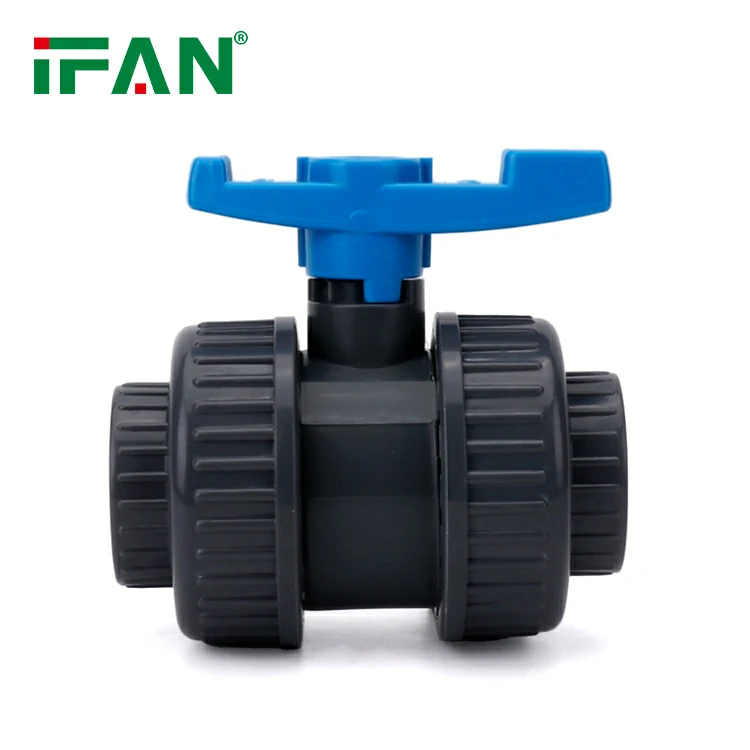The key difference between a standard PVC ball valve and a single union lies in their connection type and the ease of installation or removal. Below is a detailed comparison:
1. Connection Design
- Standard :
- A standard PVC ball valve typically has two fixed connections (inlet and outlet) that are permanently connected to the valve body. These connections can be threaded (female or male) or socketed for solvent welding.
- Single Union:
- A single union PVC ball valve has one removable connection (the union connection) and one fixed connection. This means one side of the valve can be disconnected from the pipe without disturbing the entire system.
- The removable connection allows the valve to be easily installed, removed, or replaced without cutting the pipe or disconnecting both sides. The union connection has a nut or threaded fitting that can be unscrewed, enabling easy detachment.
2. Installation and Maintenance
- Standard PVC Ball Valve:
- Installation may require joining both fixed ends with threaded or solvent-welded fittings. Once installed, removing or replacing the valve could require cutting the pipe or disconnecting both sides.
- Single Union:
- Installation is simpler because you only need to connect one side of the valve to the pipe using a union, which makes the entire process quicker. The removable connection is useful for easy installation in tight spaces or situations where frequent maintenance is required.
- Maintenance is easier, as you can simply unscrew the union connection to remove or replace the valve without disturbing the entire piping system.
3. Space and Application
- Standard:
- The valve may require more space to install and remove, especially if both ends are permanently fixed. It’s typically used in situations where regular removal or replacement is not needed.
- Suitable for installations where ease of valve removal isn’t a primary concern and where space for handling the valve is not constrained.
- Single Union:
- Ideal for applications where space is limited or where you may need to remove or replace the valve quickly and easily (e.g., in maintenance-heavy systems).
4. Cost
- Standard:
- Typically, a standard PVC ball valve is slightly less expensive than a single union PVC ball valve because of its simpler construction (no union connection).
- Single Union:
- The inclusion of a union connection makes the single union PVC ball valve a bit more expensive than a standard ball valve, but the additional cost is often justified by the ease of installation and maintenance.
5. Leak-Proof Performance
- Both types of ball valves (standard and single union) provide leak-proof performance when properly installed. However, the union connection on the single union valve must be properly tightened to ensure a leak-free seal.
Summary of Differences:
| Feature | Standard PVC Ball Valve | Single Union PVC Ball Valve |
|---|---|---|
| Connection Design | Two fixed connections (inlet and outlet) | One fixed connection, one removable union |
| Installation Complexity | Requires disconnection of both sides for removal | Easier installation with one removable side |
| Ease of Maintenance | More labor-intensive to remove or replace | Easy removal due to the union connection |
| Space Requirements | Requires more space for installation/removal | More compact and flexible in tight spaces |
| Cost | Generally less expensive | Slightly more expensive due to the union feature |
| Use Case | Used where frequent removal/replacement is not needed | Ideal for applications requiring easy disassembly or regular maintenance |
| Common Applications | Permanent installations, industrial, water systems | Irrigation, pools, spas, residential plumbing |
In conclusion, the single union is designed for applications where ease of installation and maintenance is a priority, as it allows for easy removal and replacement without disturbing the entire pipe system. The standard PVC ball valve is typically used where installation is permanent, and removal or maintenance is not frequent.
View more:https://www.ifanfittings.com/
BS 3505、BS 4346(801),ASTM D1785 SCH40(802)、ASTM D1785 SCH80(803)、DIN(804),GB(805),GB(806),
GB(901),DWV(902),ASTM D2665(903)


